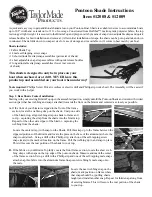
95
Scope Multimeter
Navigation
1— Peak Detect on
2— Filter on
3— Inverted trace
4— Coupling AC on
5— Sweep setting
6— Trigger setup
7— Trigger set on the rising slope
Figure 8-12
Sample data detail display
The following trace adjustments and settings are available:
•
Profile
—switches the trace for the selected channel on and off.
•
Channel
—opens a dialog box that allows you to configure the trace setup (see
on page 100 for details).
•
Probe
—opens a dialog box that allows you to select the type of test probe being used.
•
Peak Detect
—maximizes the signal sampling rate in order to capture fast events, such as
spikes, glitches and other anomalies, that may normally be undetected.
•
Filter
—smooths out the trace when the signal is disrupted by noise or other interference.
•
Inverted
—switches the polarity of the displayed signal.
•
Coupling AC
—subtracts the average value of the waveform by blocking the DC portion of an
input signal in order to amplify the AC portion. This allows small variations in the trace to
become visible.
•
Scale
—opens a dialog box that allows you to select the scale, which is the total value
displayed on the vertical axis of the display. The value shown in white at the bottom of the list
is the current sweep setting, selecting it open a dialog box that allows you to adjust the sweep
(see
on page 101 for details).
•
Slope
—only active when a trigger is set, indicates whether the trigger is set to activate on the
rising or falling slope of the trace. Selecting the slope icon switches the slope. The white dash
at the bottom of the slope column is used to set the trigger, selecting it opens the trigger setup
dialog box (see
on page 102 for details).
Summary of Contents for VERUS
Page 1: ...User Manual EAZ0061B58A Rev E ...
Page 4: ...iv ...
















































